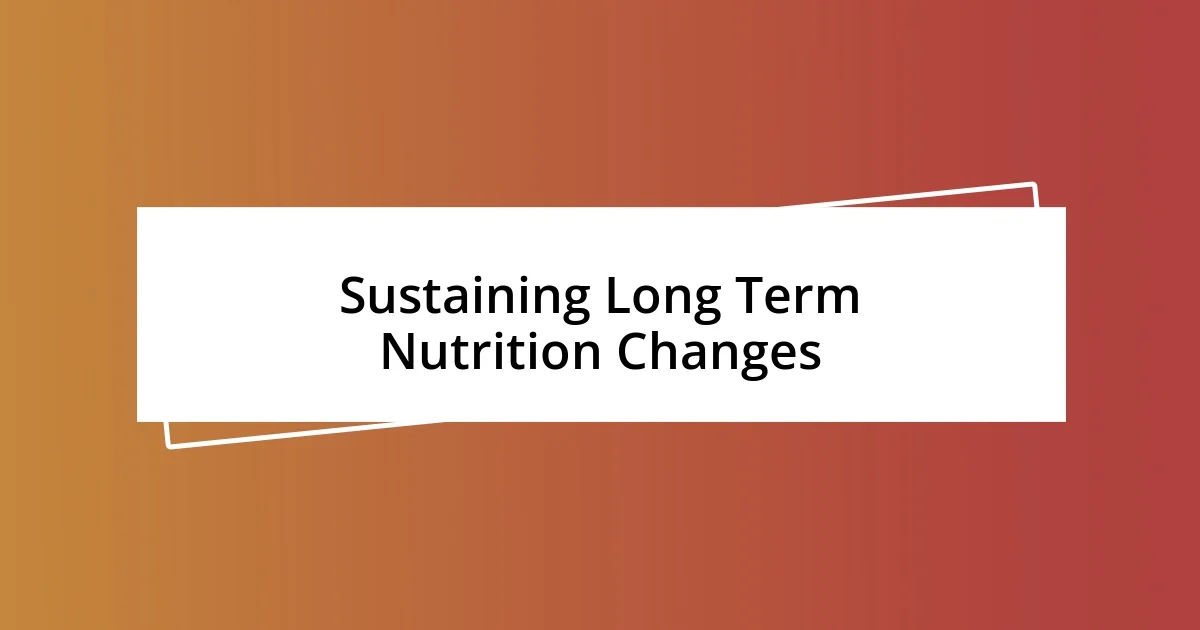Key takeaways:
- Setting specific, clear nutrition goals and breaking them into manageable steps leads to better results and motivation.
- Understanding macronutrients and micronutrients helps in creating balanced meals that nourish both the body and mind.
- Sustaining long-term nutrition changes requires flexibility, celebrating small victories, and integrating meal planning into daily life.

Setting Clear Nutrition Goals
Setting clear nutrition goals is like charting a course for a journey—without a destination, it’s easy to get lost. I remember when I first started, I floundered around choosing vague goals like “eating healthier.” It wasn’t until I specified that I wanted to incorporate more vegetables into every meal that I noticed a change. Have you ever felt frustrated by nebulous aspirations? I realized that clarity was key; it transformed my efforts into tangible results.
In my experience, breaking down broader goals into smaller, manageable steps can be incredibly motivating. For example, rather than just aiming to cut sugar completely, I started with one sugar-filled beverage and gradually switched to water. Each small victory reinforced my commitment and kept me engaged—do you think manageable steps might work for you too? I can’t express how rewarding it was to celebrate those incremental victories instead of facing overwhelming tasks.
Additionally, I’ve found it helpful to align my goals with my lifestyle and preferences. When I committed to meal prepping on Sundays, I was able to align my nutrition goals with my busy weekdays. This not only reduced my impulsive eating but also built an emotional connection with my meals—cooking became a rewarding ritual rather than a chore. Can you think of a way to make your nutrition goals resonate with your daily life too? It’s amazing how personal engagement can elevate our commitment to these goals!

Understanding Macronutrients and Micronutrients
Macronutrients and micronutrients are essential components of our diet, each playing a distinct role in our health. I once thought all nutrients were the same, but understanding their differences has sharpened my approach to nutrition. Macronutrients—carbohydrates, proteins, and fats—are the building blocks of our energy intake. Meanwhile, micronutrients, including vitamins and minerals, support various bodily functions but are required in smaller amounts. Recognizing this balance transformed how I planned my meals.
- Carbohydrates: These are our primary energy source. I started loading up on whole grains and fruits rather than processed sugars, which kept my energy levels steady throughout the day.
- Proteins: They help build and repair tissues. I discovered the power of lean meats, legumes, and nuts, which not only fueled my workouts but also kept me feeling full longer.
- Fats: Healthy fats, like avocados and olive oil, have become staples in my diet. They are crucial for hormone production and nutrient absorption while adding flavor to my dishes.
- Vitamins and Minerals: These micronutrients support immunity, bone health, and more. I now pay extra attention to colorful fruits and vegetables, which deliver a spectrum of nutrients and make my plate more vibrant.
As I learned about these nutrients, I felt empowered to craft meals that provided not just sustenance but vibrancy to my health journey. It’s almost gratifying to look at a plate and know it’s not just food; it’s nourishment. How do you view the meals you prepare? Are they simply a necessity, or can they truly be a source of wellness?

Meal Planning for Success
Meal planning has been a game changer for my nutrition success. I remember the chaos of deciding what to eat at the last minute, often leading to unhealthy choices. Now, I take an hour each weekend to outline my meals for the week. This simple act not only saves time but also enhances my creativity in the kitchen. Have you ever felt that planning can streamline your week? I certainly have!
Creating a balanced meal plan involves considering a mix of macronutrients and colors on my plate. I’ve learned that variety excites me; incorporating seasonal produce keeps my meals fresh and prevents boredom. For instance, I once dedicated a week to trying different grains like quinoa, farro, and barley. Each time I explored a new recipe, it felt like a little culinary adventure. Have you ever experimented with new ingredients to keep your meals lively? I truly believe this approach nourishes both body and spirit.
| Planning Benefits | Improvised Meals |
|---|---|
| Consistency in Nutrition | Frequent Unhealthy Choices |
| Lower Food Waste | Potential for Expiring Food |
| Time Management | Last-Minute Rush |

Tracking Food Intake Effectively
Tracking my food intake has been one of the most revealing aspects of improving my nutrition. Initially, I underestimated how much truly mattered. Using an app to log everything I eat opened my eyes to my habits—like that afternoon snack of chips I reached for without thinking. Have you ever totaled your daily intake and realized it was more than you expected? It was surprising to see how those little choices added up throughout the week.
I found that by logging my food, I became more mindful. For instance, I started measuring my portions and learned what a serving size really looked like—who knew a “handful” could actually mean so many extra calories? This newfound awareness encouraged me to be intentional about what I consumed, steering me towards more nutrient-dense options. One day, I substituted a sugary drink with water infused with lemon and mint. It felt refreshing not only in flavor but in how I viewed my choices.
Balancing macronutrients while tracking my intake was another revelation. At first, I just focused on calories, but then I began to see the importance of those nutrients. I remember a week when I hit my protein goal but fell short on my fiber intake. It made me realize how interconnected these elements are in achieving my nutrition goals. Have you considered how your nutrients work together? Embracing this holistic approach has definitely made my efforts feel more complete and fulfilling.

Incorporating Healthy Recipes
Incorporating healthy recipes into my meal planning has transformed the way I approach nutrition. One of my favorite adaptations was exploring plant-based dishes. I vividly recall the first time I made a hearty lentil stew; the rich flavors and vibrant colors not only appealed to my taste but also filled my kitchen with an incredible aroma. Has a dish ever reminded you just how satisfying healthy food can be?
I’ve also found that trying out new recipes keeps my culinary routine exciting. A few months ago, I challenged myself to cook a new vegetable each week, which led to some delightful discoveries. I never thought I would enjoy roasted Brussels sprouts or cauliflower rice as much as I do now! By embracing unfamiliar ingredients, I’ve realized that cooking can be a fun adventure rather than a chore, and that has significantly boosted my enthusiasm for healthy eating.
Another tip that I can’t recommend enough is involving friends and family in the cooking process. I once organized a healthy cooking night with my closest friends, where we each brought a recipe to share. The laughter, creative flair, and delicious food we cooked together made it a memorable experience. Do you think cooking with loved ones could spark new ideas in your kitchen? I believe that sharing recipes and flavors can deepen connections while enhancing our nutrition goals.

Overcoming Common Nutrition Challenges
One of the biggest nutrition challenges I faced was navigating cravings, especially when stress levels soared. I remember a particularly tough week at work when I couldn’t resist the call of my favorite chocolate chip cookies. It hit me then: instead of just giving in, I could find healthier alternatives to satisfy that sweet tooth. This realization led me to experiment with recipes using mashed bananas or almond flour, giving me similar flavors but fewer empty calories. Have you ever swapped an ingredient and been surprised how much you enjoyed the result?
Dining out also posed its own set of hurdles. I’ve had moments sitting at a restaurant, staring at the menu, feeling overwhelmed by all the tempting options—pasta smothered in cream sauce called to me like a siren. But I learned a trick: I would look for grilled or roasted proteins and vegetable sides first before venturing to the more indulgent choices. In those instances, I felt proud of creating a balance. It empowered me to enjoy social outings without compromising my nutrition goals—have you ever felt that blend of temptation and determination when dining out?
Lastly, I had to confront the social pressures surrounding food, particularly at gatherings. I distinctly remember a holiday party filled with delicious treats everywhere I turned, making it easy to lose track of my intentions. I started to communicate my goals with friends and family, allowing them to support me by providing healthier options or simply understanding when I opted for lighter fare. This led to a more supportive atmosphere, and honestly, the conversations about nutrition made me feel less alone in my journey. Have you found that sharing your goals can foster a more supportive environment? I believe it can truly transform the way we view food in social spaces.

Sustaining Long Term Nutrition Changes
Maintaining long-term nutrition changes often requires building habits that feel more like a lifestyle than a diet. I remember when I first switched to meal prepping every weekend; it transformed my weekday routine. At first, it felt like a chore, but over time, I appreciated the time I saved during busy weeks. Have you ever noticed how a little planning can alleviate stress in your daily life?
Another crucial element for me was celebrating small victories along the way. A few months after adopting healthier eating habits, I treated myself to a new kitchen gadget that made my meal prep even more enjoyable—a spiralizer. I distinctly recall the excitement I felt spiralizing zucchini into noodles. Every time I used it, I was reminded of my commitment to better nutrition, reinforcing my desire to stick with my goals. How do you celebrate your progress?
Lastly, I realized the importance of flexibility in my nutrition journey. There were times when I strayed from my plan, perhaps indulging in dessert at a birthday party. Instead of feeling guilty, I learned to embrace those moments and see them as a part of life. I remember one particular birthday where I enjoyed a slice of cake without hesitation, knowing that it didn’t undo all my hard work. I asked myself, is it worth sacrificing joy for the sake of rigid rules? This perspective shift allowed me to sustain my nutrition changes without feeling deprived, making my journey both enjoyable and fulfilling.













